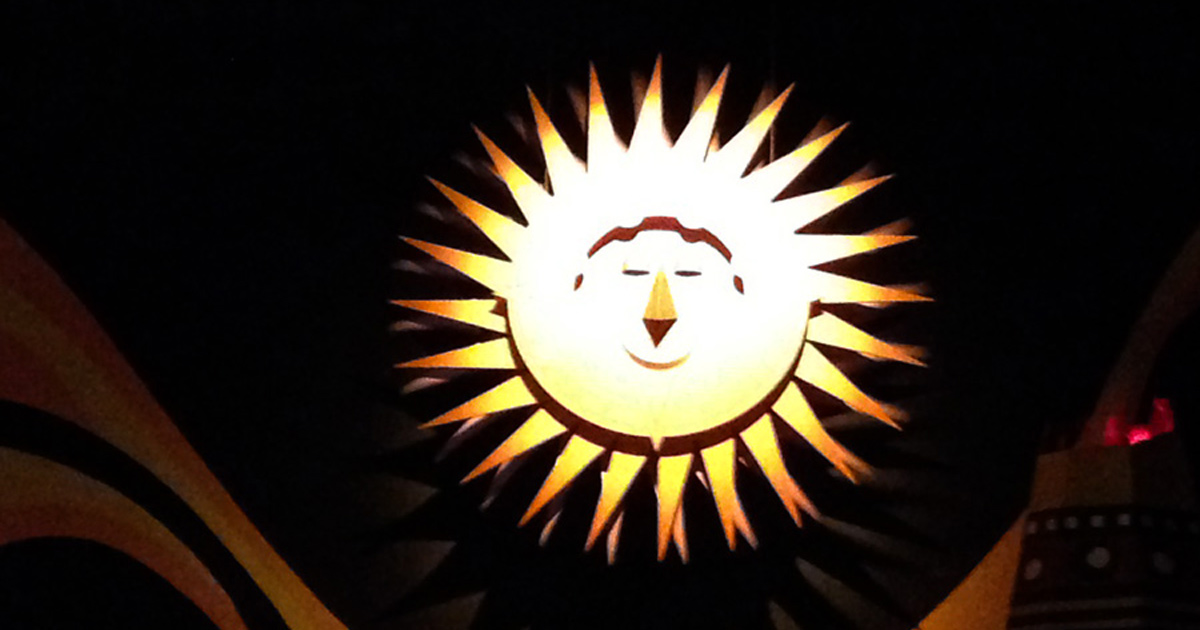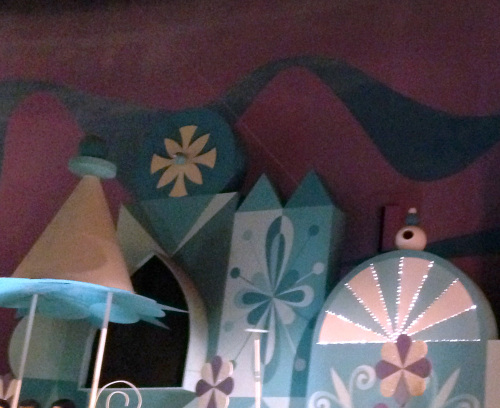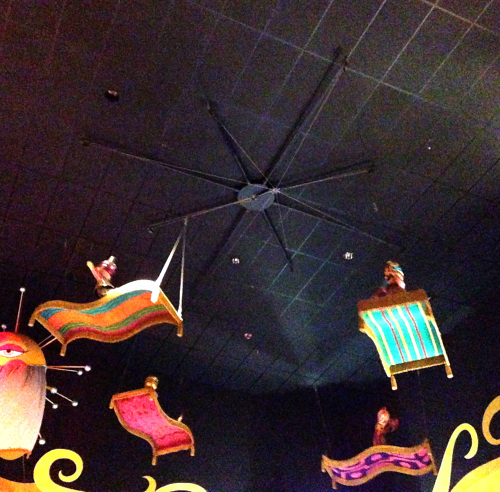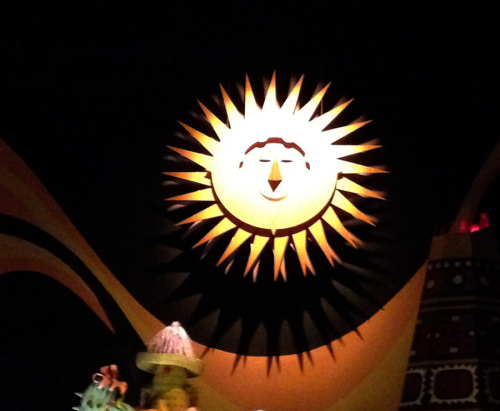
No one considers “it’s a small world” a crowning technological achievement. Its charm is in its simplicity. Yet there are several ingenious low tech effects that actually make the whole thing work.
The beauty is that these clever gadgets just blend in. They’re just part of the scenery. They don’t require an atmosphere-controlled data center with a rack of high-speed servers to keep the whole ride from going 101. They just work, baby.
“101” is Disney Cast Member code for a ride shutting down. This may or may not have something to do with the number of Dalmatians in a classic Disney film.
– Walt Disney World 101
The Magic Carpets
You see multiple versions throughout the ride, most obviously in the “Asia” room. As you float past the Taj Mahal and that weird multi-limbed shadow puppet lady, magic carpets circle overhead. As you stare in awe, they rise and fall like galloping horses.
The circling part is easy. It’s a turntable with cables suspended it from it. But how to do the dipping?
Maybe some motors to individually raise and lower each carpet. Except that there are four carpets on each turntable. Meaning four motors that might potentially break down. And what if they aren’t synchronized? The carpets would lose their smooth, flowing path.
Fortunately, the Imagineers came up with an ingenious low tech special effect.
There’s a little arm up there mounted under the turntable, turning in the opposite direction. The noses of the carpets are tethered to the arm, which continuously shortens and lengthens the various cables by virtue of its offset axis. It keeps the carpets in perfect synchronicity, undulating like a ride on an invisible roller coaster.
It’s just pulleys, cables, and turntables. A low tech effect for perfect motion and minimal maintenance.
One Blazing Sun
According to the song, there is just one moon and one golden sun. And we have already exposed as a complete falsehood. But one of our favorite low tech effects is the sun in the South America room. Or maybe it’s Mexico. Which is technically North America. Ugh, Small World geography.
This sun is one of the few kinetic suns in the ride. It’s beams continually radiate light, in spite of the fact that thing is made out of plywood. This is not accomplished with electronic light controls or programmable armatures.
Rather, it’s our familiar old friend, Mr. Turntable.
First, you have the static sun, which is just a static Mary Blair cutout. It sticks out from the wall, with its sunbeams spiraling around it in a series of triangular spines.
Behind it is another cutout sun of the same pattern. Except this one is a mirror image, so that its spines are angled the opposite direction. As the turntable rotates, it progressively exposes more of the of the sunbeam with each degree. It creates an optical illusion that the sun’s rays are pulsating outwards.
Cyclist on Tight Rope
This low tech effect is frequently broken at Walt Disney World, but Tokyo Disneyland still has it in all its glory. In the last room (Antarctica? Ugh, Small World geography), you can spot a cable strung between the walls across the channel. This cable is home to a circus performing cyclist doll. He wheels back and forth across the thin thread.
One look at the cable’s thickness and you can see that this actually is kind of an incredible feat. They have some kind of animatronic-mannequin-whatever literally cycling a tightrope over a boatful of guests. They clearly did not anchor the guy to the rope. He continually moves back and forth.
Why are they so sure that he won’t fall off?
Part of it is balance. The cyclist himself is very light. He carries a long pole crossways, upon which two other acrobats are dangling from each end. These guys are weighted so that their heaviest mass is actually drooping down below the wire. The sheer force of gravity keeping them upsetting the applecart. This low tech effect is a simple system of counterbalances.
That’s all well and good, but how does the cyclist then move back and forth? Do they have a little motor in there making the guy pedal? As we’ve already said, complex motors are prone to break down, and this one would need to keep the cyclist moving backwards and forwards, always hitting his mark.
Fortunately the answer is much simpler. There is a motor involved, but gravity provides the heavy lifting.
They cable raises and lower between a span of about twelve inches on the wall. Lower the cable and you create an incline, the cyclist starts rolling downhill. Raise the cable and you’ve now reversed the incline. He cycles backwards the way he came. It keeps him moving along the same path.

Summary
None of these low tech effects are all that spectacular when you look at them, but their cleverness has always fascinated me. Check them out the next time you’re on the ride.






Any idea what is used to make the smiling clock face on the entrance tilt back & forth? Trying to recreate for a retail window. Thank you!
Some sort of motor. I know that doesn’t help, LOL.
I have a dream.. one day there will be a person given a position of power in the Disney corporation. That person will have more than half a brain. They will look at the most beloved attractions and see how simple they are… realize they could not only refurbish the old ones but give us many more for less than the cost of one of the high tech, heartless monstrosities we wait years and years for while the parks crumble into disrepair and classic rides are destroyed.. and the vision of Walt will live again. I hope I am still alive to see them with my grandkids.
I had never noticed how the tight rope cyclist cable would raise and lower. Neat! Hopefully it will return soon.
I have always loved the low-tech effects on Disney attractions. That’s a big part of the reason why the newer animated Hitchhiking Ghosts at WDW kind of bum me out. There was considerable charm to knowing that really-real figures were rolling along behind those mirrors, and not to mention the added bonus of their creaky movement. It is a trait so intrinsically a part of the characters that the Mickey’s Boo-to-You Parade Haunted Mansion float performers emulate the jerky movements in their choreography.
One hundred times YES! I really miss those creepy guys. It’s like the difference between movies with handcrafted special effects and puppets (think “Labyrinth”), and the modern computer-animated movies. The CG ones have their own charm, but the old ones have something so real and raw about them. I hope Disney never gets rid of all the simple effects we love so much. I better never see them replace that “pirate ship out on the water” effect you see when you first board your boat at WDW’s Pirates with a video screen.